Zagato versions of the Aston Martin DB4 GT are justly famed, but the standard car has a more subtle appeal. Andrew English goes on a voyage of exploration through the English Peak District
Words: Andrew English, Photography: Jamie Lipman. November 2014.
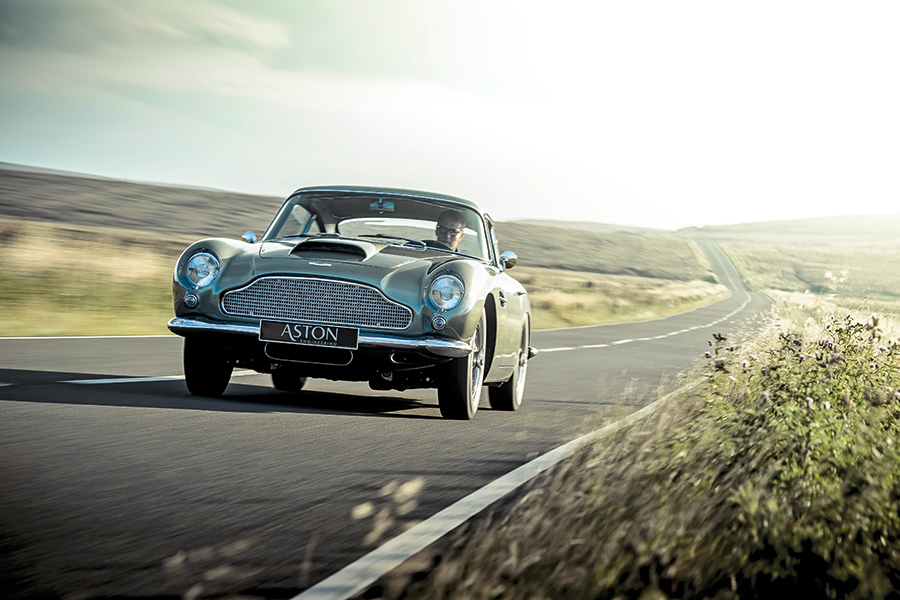
The bunch of Wilmot Breedens chinks around your pocket like loose change. You furtively sort through them. Is that one ignition? Driver's door? Boot? Comedy handcuffs? No wonder we used to mark the keys with girlfriends' nail varnish. Finally find the right one, climb in and pull the door closed with a heavy flapping noise, like all 1960s Aston Martins make. Wow, a-million-and-a-half quid and you're all mine; well, at least for this morning.
Aston Martin's DB4 GT, one of the most coveted models built in the company's 101 years. Just five inches out of the wheelbase, a few more horses and 85kg less to carry, it wasn't that different from the DB4 from which it was derived, yet its proportions are so perfect, the lack of adornment so tasteful and the detailing so right, it makes car design look simple.
The GT was built to go racing, at which it didn't excel, but it remains one of the marque's icons even if the vast majority of 95 built (the Touring of Milan-bodied models) are overshadowed by the 19 Zagato-bodied GTs – plus six modern 'Sanction' II and III models. Even former Aston Martin boss Uli Bez was beguiled by the Zagato, as Ian Callum, formerly Aston's design chief once observed: 'I wish he'd never seen the Zagato,' he sighed at the launch of the original Vanquish in 2002. 'I wanted to talk to him about the lithe and flowing lines on the DB4 and GT, but he turned the page, saw the DB4 GT Zagato and that was it, he wanted nothing else after that.'
But is the DB4 GT any more than a good-looking whip with a limited production run? Are its current values just the piss and wind of an uncomfortably toasty classic car market, or is there something about this machine that's worth the hyperbole?
'Its proportions are so perfect, the lack of adornment so tasteful, it makes car design look simple'
The high-pitched starter whirls so fast you'd wonder if there's compression, connection, or even engagement. Then there's a cat fight under the bonnet as the engine catches and three Weber twin-chokes sidedraught fuel and air in, which waffles out of the exhausts. That's a bonus since GTs can spit back when starting and ignite the spilled petrol in the airbox. And it's then that you need to get it started, chop chop, to suck the fire back into the cylinders.
So deep breaths and let the all-aluminium engine warm as you stare around at the seven-dial dashboard, clearly borrowed from a 1950s space rocket. Full-scale-deflection gauges, all Smiths: oil pressure and temperature, water temperature, revs, speed, fuel and an ammeter. Soft black plastic pull knobs embossed with single letters to operate mysterious functions – S, R and C? What could they possibly mean? The steering wheel is a huge riveted wood-rimmed device in your lap, and gear selection is via a knitting needle poking out of the transmission tunnel, topped with a walking-stick rubber. All the while your derrière is gently and creakingly accommodated by the leather armchair that appears to have been fitted in place of the driver's seat.
But just listening to the cacophony of aluminium and iron getting accommodated brings it all flooding back. That summer of 1990 when Geoff Harris dropped a Biro on my kitchen table. 'That,' he said with a grin, 'is where you take it if you bin it.'
The Biro belonged to Bodylines of Olney, artists in aluminium who would, if you crossed their palms with silver, make good the damage. Even a quarter-century ago, a DB4 GT was worth up to £250,000, which was comfortably more than the value of my house, and Harris was about to hand over the keys to his GT to me for the following day's Aston Martin Owners' Club Goodwood Sprint. I might have gulped.
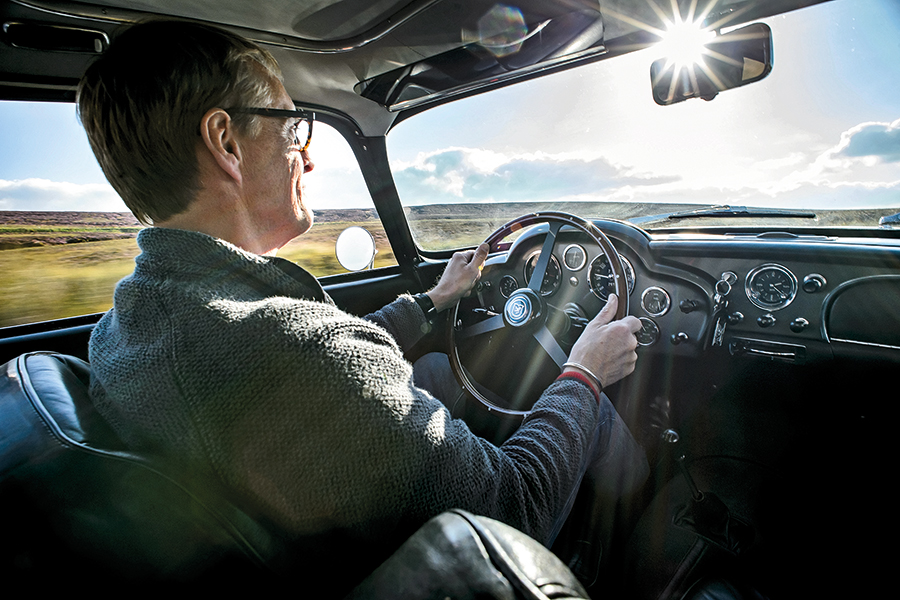 John Wyer, Aston Martin's legendary competitions manager, said the DB4 GT was a car where everything was just a little closer to the edge. In fact he thought it wasn't as stable as the DB4 from which it was chopped. Well it wouldn't be, would it? On narrow L-section racing tyres, skilled drivers could powerslide the short-wheelbase GT around such airfield tracks as Goodwood, Silverstone or Snetterton. Dancing almost 1.3 tons of British muscle in pursuit of the lead Ferrari (always a Ferrari), Innes Ireland, Roy Salvadori, Jim Clark, or Stirling Moss four-wheel-drifting through Beckett's or Madgwick provided the images from which this car's reputation was hewn. But all is not quite what it seems.
John Wyer, Aston Martin's legendary competitions manager, said the DB4 GT was a car where everything was just a little closer to the edge. In fact he thought it wasn't as stable as the DB4 from which it was chopped. Well it wouldn't be, would it? On narrow L-section racing tyres, skilled drivers could powerslide the short-wheelbase GT around such airfield tracks as Goodwood, Silverstone or Snetterton. Dancing almost 1.3 tons of British muscle in pursuit of the lead Ferrari (always a Ferrari), Innes Ireland, Roy Salvadori, Jim Clark, or Stirling Moss four-wheel-drifting through Beckett's or Madgwick provided the images from which this car's reputation was hewn. But all is not quite what it seems.
For a start those cars simply devoured tyres. Fellow Octane writer Tony Dron once calculated that, in one Goodwood Tourist Trophy, Roy Salvadori's DB4 GT Zagato ate through 14 Dunlops in a fruitless pursuit of Stirling Moss in a Ferrari. The heavier Touring-bodied GTs would have been harder still on their rubber.
These days most GTs run on slightly wider tyres made of better compounds, which grip harder and relinquish it later but more suddenly, so you need to have a care. That and the fact that engines give a lot more power and drivers are more used to cars that go roughly where they are pointed means that, like the three-wheeling Lotus Cortinas of yore, the endlessly drifting Aston GT is a rare bird. Take a track test for Auto Express magazine we did with Geoff's GT and a handful of more modern Aston Martins with Eddie Irvine in 1996, the year he signed for Ferrari alongside Michael Schumacher. He whammed round Castle Combe in all the cars bar one: Geoff's.
'They were brave old boys who raced those cars,' he said of the old warhorse – muttering later that he hated driving it and thought it was a pile of crap.
Powersliding is the last thing on my mind as we start out on the Derbyshire Peak District. Orwellian average-speed cameras have you wondering about the accuracy of the wavering speedometer, and gawpingly wayward tourists don't make an easy time of low-speed, high-value GT motoring. Just manoeuvring the thing requires strong shoulders, and the flexible wooden wheel protests, along with the tight limited-slip differential, which drags the inside rear wheel and makes it easy to stall. Then there's that impressively engineered (but useless) fly-off handbrake, which means your right foot has to dance between brake and throttle to avoid rolling backwards. Get the clutch up and the Watt's linkage on the rear axle creaks and clunks as the drive comes in.
And like pretty much all Astons of the period, a GT feels a bit hopeless at normal speeds. So little of it appears connected, it's like driving a signal box. The throttle linkage eschews linearity at very low speeds, the twin-plate clutch rises abruptly, and then there's an almost absurd precision about the David Brown four-speed, which demands a surgeon's hands. It might have the careless elegance of a thoroughbred from outside, but in the cockpit you're working quite hard at maintaining that impression. Slow corners demand about twice as much steering lock as you thought and, as the suspension loads up, so does the steering, so you sneak an extra bit of road to make the corner gentler. Bumps in the road have the bonnet porpoising and those period Avon Turbospeeds nose down cambers, creases and cracks like bloodhounds on the scent. And this is after Aston Engineering has applied some of its sensible and worthwhile suspension modifications to this car, which belongs to an Austrian collector. 'We haven't had a lot of time with it,' says MD David Jacks. 'Enough to have de-messed some of the messed-up bits and it's now a pretty straightforward road car. It certainly handles a lot better than they did back in the day.'
There are a couple of articles you see about quick DBs, both to be discounted. First one runs along the lines of 'it's brilliant and I drifted it everywhere', and the second is that 'it understeers, overheats and is awful'. No Aston should overheat if properly looked after, so deep-six that impression. As for the understeer, it's true that there's a lot of weight up front, but you don't so much understeer as misjudge corners in a DB4 GT. Even on the road, you need to think about the corner in advance, determine your entry and exit points and then helm the car through. That way it's loaded up gently, it's in the right gear and you're on top of it. Then this car really comes alive.
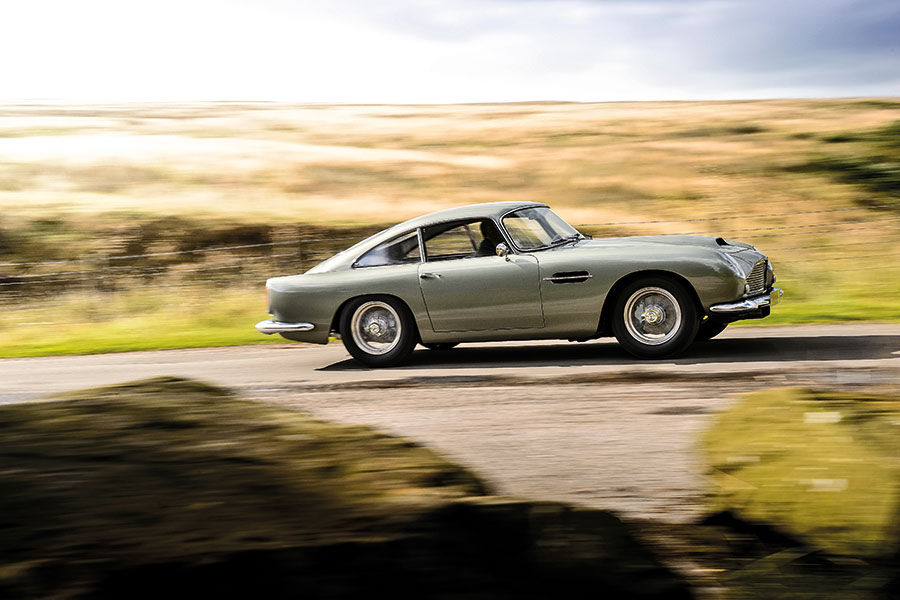
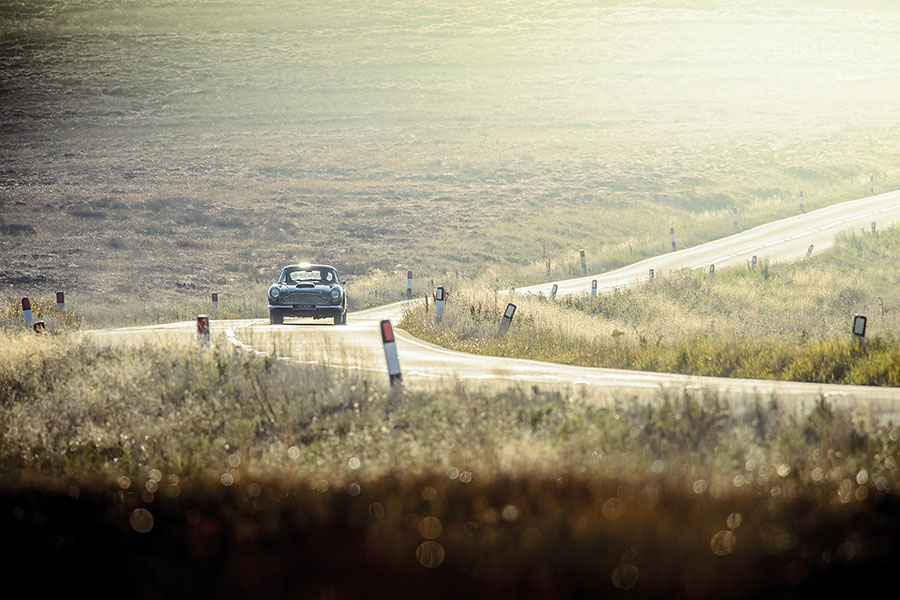
Over 3000rpm the engine is up on a wall of sound and torque, climbing its way to somewhere saucily addictive. Keep your foot in, bathe in the aristocratic wail and watch the revcounter as the horizon comes to you. If you're on it like jam on toast this is seriously quick. Same with the handling. 'Driving is a dance in a way,' commented Stirling Moss, and it certainly is in a GT. No one with a mind for a long life out of Her Majesty's Prisons drifts a car round corners as a matter of course, but if it happens to start to slide, drift even, you're there, ready and it's so instinctive and intuitive to turn the wheel, adjust the throttle, relax and...
At one point Geoff's car held virtually every British DB4 GT lap and hillclimb record, so what was it like to drive very fast? 'It was such a monster six-cylinder,' he said, 'you felt like the entire car was just spinning round the crankshaft. There was always that feeling of floating, almost dancing. Like Blanchimont at Spa-Francorchamps, where you'd be hanging on the big wooden wheel with your heart in your mouth, or Bunny's Leap at Wiscombe hillclimb when you'd wonder if she'd be able to claw her way back and get through the gate.
'At the 1990 Manx Classic,' recalls Geoff, modestly forgetting to mention that he won it outright, 'it was sliding very sideways at Signpost corner, but it dug in so hard as I put the power on that it felt like each tiny piece of Tarmac was grabbing every one of the tyre-treads – what a wonderful feeling.'
But they aren't all joy. The expense is fathomless and bills relentless, and those thin-gauge bodies are so very vulnerable. 'I once caught the front wing while taking it out of the shed,' says Harris, 'carried on and caught the rear wing on the same obstruction. That was awful.'
But if the upkeep can be a miserable nadir, the zeniths are stratospheric. 'I've always liked the Touring DB4 GT better than the Zagato,' says Peter Snowdon, an Aston racer who's driven both. I know what he means: a ton of mixed feelings, but ultimately an addictive high – on road and even more so on track: I can vividly recall the controlled drift at Madgwick in Harris's GT followed by a less controlled one at Fordwater. My heart was beating so fast at the flag I went for a quiet sit down. But if I'm reminiscing, allow an old fella a bit of a daydream. I've still an hour or two before I have to hand the keys back.
1959 ASTON MARTIN DB4 GT
Engine 3670cc straight-six, DOHC, three twin-choke Weber 45DCOE carburettors
Power 300bhp @ 6000rpm
Torque 240lb ft @ 5000rpm
Transmission Four-speed manual, rear-wheel drive
Steering Rack and pinion
Suspension Front: double wishbones, coil springs, telescopic dampers, anti-roll bar. Rear: live axle, radius arms, coil springs, Watt's linkage, telescopic dampers Brakes Discs
Weight 1270kg
Performance Top speed c150mph. 0-60mph 6.1sec
THE COMPETITION HISTORY
No Le Mans wins, no great championship victories. But, then, sometimes the taking part is what counts
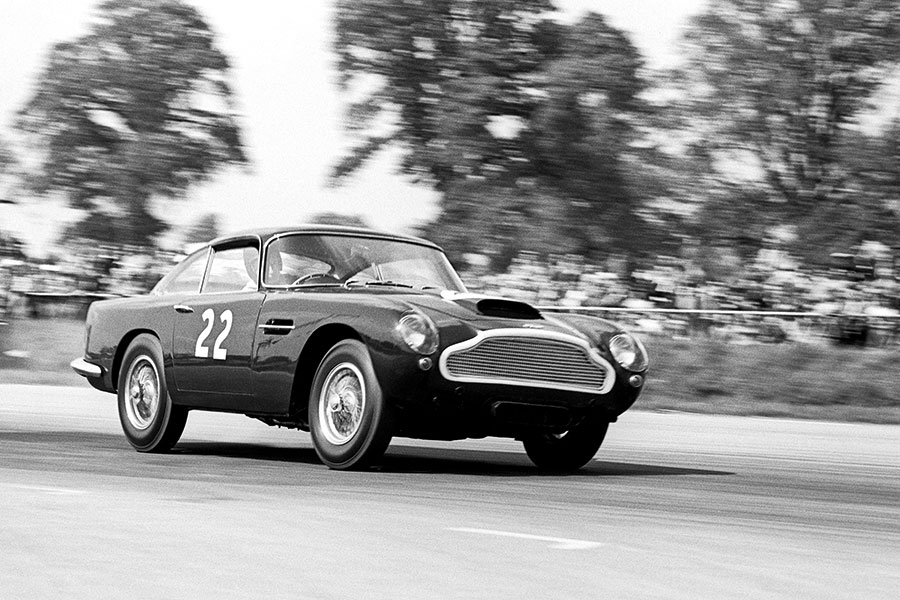 The first works DB4 GT made its debut in 1959, when chassis DP199/1 was entered into a GT event at the International Trophy meeting at Silverstone on 9 May. With no production cars built and no homologation, Reg Parnell was rather anxious about the car's legal status. The same car was entered for Le Mans with a 3.0-litre engine from DBR3/1 under the bonnet but, with Swiss drivers Hubert Patthey and Renaud Calderari behind the wheel, it lasted just 21 laps of the French classic.
The first works DB4 GT made its debut in 1959, when chassis DP199/1 was entered into a GT event at the International Trophy meeting at Silverstone on 9 May. With no production cars built and no homologation, Reg Parnell was rather anxious about the car's legal status. The same car was entered for Le Mans with a 3.0-litre engine from DBR3/1 under the bonnet but, with Swiss drivers Hubert Patthey and Renaud Calderari behind the wheel, it lasted just 21 laps of the French classic.
The following year, the factory built five lightweight cars, with one going to Tommy Sopwith's Équipe Endeavour and a pair to John Ogier's Essex Racing Stable. Stirling Moss drove the Sopwith car to victory at the Goodwood Easter Monday meeting and Jack Sears won with it at Aintree, then Oulton Park, Snetterton and Brands Hatch against fairly soft opposition. Ogier's cars faced a tougher test at the Goodwood Tourist Trophy in August, in the form of six Ferrari 250GTs, including Rob Walker's with Moss at the wheel. It wasn't much of a contest and by the flag Moss, who had tuned into Raymond Baxter's radio commentary of the race to determine how fast to drive, was a lap ahead of Roy Salvadori and Innes Ireland in the DB4 GTs. It was the same story at Brands Hatch a week later and again in the Montlhéry Paris 1000km.
Ogier took on two Zagatos, but retained one of his old DB4 GTs. The old car, 0151/R, was given a run out in March for Salvadori at Snetterton, but it was no match for the Ferraris. Ireland managed to split the new racing E-types in 0151 at Oulton Park, and Jim Clark and Bruce McLaren had a fairly torrid Nürburgring 1000kms in the same car, retiring on lap 25. Again the Goodwood Tourist Trophy was a Moss/Ferrari 250GT benefit, with Ireland in 0151 placed fifth.
And that really was it for the DB4 GT and top-line racing. Ferrari's 250GT might have had more agricultural suspension, but it was almost 25% lighter than the Aston and Jaguar's coming E-types were looking threateningly quick. By 1962 and the launch of the Ferrari 250GTO, the old DB4 GT and its Zagato-bodied sisters were obsolete. David Brown, who wanted to race at Le Mans again, sanctioned the development of the Project Cars. While based on the DB4 GT chassis, they became progressively further removed from the road cars and were raced with mixed success from 1962 to 1963, before being sold to the Hon John Dawnay (Viscount Downe) who raced at Le Mans. The car ran strongly but was disqualified.
Lists, as Donna Elvira finds when sung the details of her lover's 2065 former conquests in Mozart's Don Giovanni, don't always contain the best of news. Fans of Aston's DB4 GT might have a similar reaction to the long litany of races this car didn't win. But when the epitaph is written, the Aston that was too heavy and not fast enough also left an indelible impression, with its stentorian note, its chuckable nature and its beauty. Failure is too damning a phrase, because these days they're as coveted as they ever were. And if they're not at the front you can be sure they're making plenty of noise from somewhere on the grid.
THE ASTON TIME FORGOT?
Caught between the cheaper DB4 and the sublime Zagato, the DB4 GT has forged a lesser-known life story
In 1956, a year after he joined Aston Martin from Austin, Tadek Marek started work on a 3.7-litre straight-six, codenamed DP (Development Project) 186. He was determined to build an all-new engine, stronger and capable of delivering more power than the outgoing Willie Watson/Walter Owen Bentley LB6 unit. A lack of casting capacity in cast iron meant he was forced to have it cast in aluminium alloy, which proved the making of the engine – and in some senses its downfall...
Inside the aluminium wet-liner block, Marek gave his engine a strong, seven-main-bearing Laystall crank running in plain bearings, a huge oil pump and a massive sump, topped off with an aluminium-alloy cylinder head, with hemispherical combustion chambers and 12 large valves 80º apart, actuated by twin chain-driven camshafts. Displacing 3.67 litres, the engine's 92mm bore and stroke gave it exactly 'square' dimensions – the days of the old tax-mandated long-stroke engines were at an end.
Around this time work was also started on a replacement for the DB2, codenamed DP114. While Marek's engine work bore fruit and was being bench-tested by 1956, the concomitant car project wasn't considered beautiful enough and the project was restarted in cooperation with Carrozzeria Touring of Milan.
There's a bar room story told to me but never authenticated by former Aston Martin historian Roger Stowers, about a young Aston Martin engineer meeting either Carlo Anderloni, son of Touring's founder Felice, or (depending on which bar you are in) co-founder Gaetano Ponzoni on a train. They got talking and the engineer revealed he was on his way to Italy to find a coachbuilder to help build a new range of Aston Martins. When the engineer showed the Touring man a suitcase full of money, his face lit up. 'You must come and see our workshop,' he suggested, and the deal was done. While this scenario seems unlikely, it is certainly true that Aston Martin designer Frank Feeley had made an influential visit to Italy after the war and that Touring had worked with the company on a series of Spider models based on the DB2 in 1956.
Marek's engine debuted in 1957 under the bonnet of the DBR2 sports racing car. Around that time, the first fruit of the road car project was produced in prototype form. Codenamed DP184 and destined to become the DB4, this was a typically over-engineered Harold Beach design, with a steel platform chassis suspended on front wishbones and coil springs, and a live rear axle carried on parallel links with a Watt's linkage and coil springs with lever-arm dampers, and steered with a manual rack-and-pinion. The car bore Touring's patented Superleggera construction method of 16-gauge aluminium alloy panels shaped by craftsmen and laid over a cats' cradle of small-diameter steel tubes. At the points where the tubes met the aluminium, they were wrapped in cotton tape, which when wet was a first-rate source of electrolytic corrosion.
The DB4 road car was first seen at the Earls Court motor show in 1958, but a trade union dispute delayed production for almost 12 months. So shortly after the first DB4s were reaching their lucky customers its shorter, lighter and faster sister, the DB4 GT, debuted at the 1959 show. While the company was flat out competing in and winning the 1959 World Endurance Championship, the DB4 GT was a way of keeping its customers interested in motor sport, being the sort of car you could (just about) drive to work in the week and compete in at the weekend.
Little was different about the specification, although Beach petitioned unsuccessfully for a new de Dion rear suspension. The wheelbase was reduced by five inches to 7ft 9in, there was a twin-plate clutch and the engine was given twin-plug ignition using twin distributors running off the back of the camshafts. With triple twin-choke 45DCOE Weber carburettors, a slightly higher compression ratio and more radical cam timing (the cam profiles were the same), Aston claimed 302bhp at 6000rpm, an idea David Jacks at Aston Engineering finds amusing. 'We reckon that as standard the 3.7-litre engine produced between 270 and 280 horsepower,' he says.
The gearbox was a four-speed David Brown unit with a close ratio set and synchromesh on all speeds, a Powr-lok limited-slip differential was fitted, and the disc brakes were from Girling. The headlamps were cowled under Perspex covers, most cars received a 30-gallon fuel tank with twin fillers, and some of the cars were clad in 18-gauge magnesium aluminium coachwork, with aluminium replacing steel in some non-stressed parts of the chassis. While the standard DB4 cost £4000, Aston asked £4500 for a GT – nearly £6 for each one of the 85 kilograms saved. In total, 75 were built.
At the following year's London Motor Show, the company showed an even lighter version: the Zagato. Priced at £5470, it was an exotic machine and a slow seller; only 19 were sold, although it is rumoured that a couple more were built and subsequently cut up for scrap. The cars were shipped out to Italy and had their bodies beaten out in the Italian manner rather than wheeled as we do in England. The body saved another 45kg and looked a great deal more eye-catching. Engines had an even higher compression ratio and a thinner top ring, with the factory claiming 314bhp. The basic design was that of a young Ercole Spada, one of his first projects for the company, but each car differed slightly.
Never that successful in competition, the DB4 GTs were nevertheless glamorous and much sought after by collectors, especially the Zagato models. Their design went on to form the backbone of a series of Project racing cars designed for the prototype endurance racing regulations. Their rarity and value spawned a host of alternative DB4-based race cars, including Viscount Downe's highly modified DB4 racers, and Richard Stewart Williams' lightweight cars, which proved a (slightly) more affordable way of going Aston Martin racing.
For more from the historic car world, try Octane magazine.
Subscribe today and get 5 issues for £5, plus a FREE welcome gift.